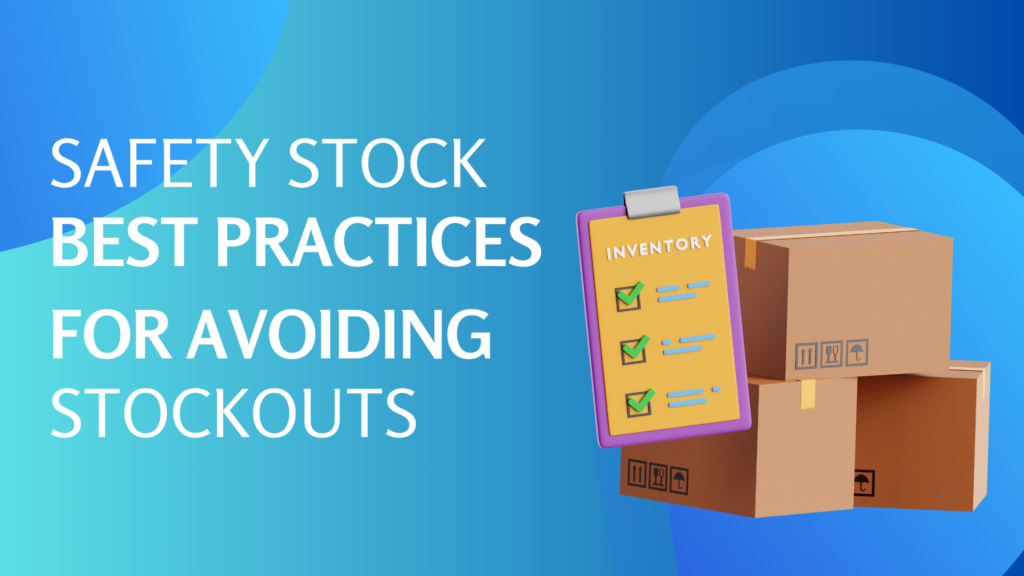Safety Stock Best Practices for Avoiding Stockouts
Do you ever worry about running out of stock? Fear not! Safety stock is your secret weapon. It’s like an extra cushion in your supply chain, protecting you from unexpected bumps like high demand, delays, or forecasting mishaps. This blog reveals the best ways to calculate and manage this handy buffer, keeping your business smooth and achieving your goals.
The Importance of Safety Stock
Running out of stock can have detrimental effects on businesses, leading to lost sales and dissatisfied customers. According to a study by IHL Group, stockouts result in $984 billion worth of lost sales worldwide, with North American companies alone losing $144.9 billion. Having safety stock on hand can help businesses offset demand uncertainty, avoid stockouts, and minimize the effects of supply disruptions. It also enables businesses to ensure customer satisfaction, maintain market share, and increase overall efficiency.
Factors to Consider in Calculating Safety Stock
To accurately calculate safety stock, there are several key factors that need to be considered. These factors include demand variability, lead time variability, service level targets, and seasonal variations. Let’s take a closer look at each of these factors:
Demand Variability
Demand can fluctuate for various reasons, such as seasonal impacts, sudden shifts in customer trends, panic buying, or a competitor’s departure. It is essential to analyze historical demand data and identify patterns to understand demand variability better. By considering demand variability, businesses can determine the appropriate level of safety stock needed to meet unexpected spikes in demand.
Lead Time Variability
Lead time variability refers to the variations in the time it takes for suppliers to deliver inventory. Unexpected disruptions on the supplier side, such as raw material shortages, production issues, or operational shutdowns, can have a significant impact on lead times. By analyzing historical lead time data and understanding lead time variability, businesses can calculate safety stock levels that account for these uncertainties.
Service Level Targets
Service level targets define the desired level of customer service a business aims to achieve. It represents the probability of not experiencing a stockout during the replenishment lead time. By setting appropriate service level targets, businesses can determine the optimal safety stock levels that align with their customer service objectives.
Seasonal Variations
Many businesses experience seasonal variations in demand, where certain periods require higher inventory levels to meet customer needs. It is crucial to analyze historical data and identify seasonal patterns to account for these variations in safety stock calculations. By adjusting safety stock levels based on seasonal variations, businesses can ensure that they have adequate inventory to meet increased demand during peak seasons.
Safety Stock Formulas
There are various formulas available to calculate safety stock levels, depending on the specific needs of your business and the variables you consider. Let’s explore some commonly used safety stock formulas:
Basic Safety Stock Formula
The basic safety stock formula is a simple and straightforward way to estimate safety stock levels. It takes into account the number of products sold per day and multiplies it by the number of days’ worth of safety stock necessary.
For example, if a company sells 200 items per day and wants seven days’ worth of safety stock, the calculation would be 200×7, resulting in a safety stock of 1400 units.
Standard Deviation Safety Stock Formula
The standard deviation safety stock formula is useful when dealing with multiple uncertain variables. It incorporates factors such as the number of orders expected to be fulfilled in a given period, the standard deviation of lead time, and the average amount of demand within that period. Calculating the standard deviation of lead time and demand requires some complex math and is difficult to solve. But with standard deviation calculator, this complex calculation can be done quickly.
Average – Max Safety Stock Formula
This formula calculates the average maximum number of units needed at any given time. It takes into account the maximum amount of sales, the maximum lead time, the average amount of sales, and the average lead time.
Safety Stock with Variable Demand Formula
This formula is suitable for situations where the lead time is reliable, but the demand varies. It considers the standard deviation of demand and the average delay in supplier orders.
Safety Stock with Variable Lead Time Formula
This formula is used when demand is stable, but lead time fluctuates. It factors in the desired service level, average sales, and the lead time deviation.
It is important to note that these formulas provide a starting point for estimating safety stock levels. Each business should adjust and fine-tune these formulas based on their specific needs, historical data, and market conditions.
Best Practices for Managing Safety Stock
Once safety stock levels have been calculated, it is crucial to effectively manage and maintain them. Here are some best practices for managing safety stock:
- Regular Review and Adjustment – Safety stock levels should be regularly reviewed and adjusted to align with changing business needs and market conditions. Factors such as changes in demand patterns, supplier lead times, and seasonal variations should be taken into account when determining safety stock levels. By conducting regular reviews, businesses can ensure that their safety stock remains accurate and up-to-date.
- Collaborative Planning with Suppliers – Maintaining effective communication and collaboration with suppliers is essential for managing safety stock. By sharing demand forecasts, lead time data, and other relevant information, businesses can work together with suppliers to optimize inventory levels and reduce the risk of stockouts. Collaborative planning helps improve supply chain visibility and enables better coordination of inventory management efforts.
- Use of Inventory Management Software – Leveraging inventory management software can greatly simplify and streamline the process of managing safety stock. These software solutions provide advanced analytics capabilities, demand planning tools, and real-time inventory tracking, allowing businesses to make data-driven decisions and optimize their safety stock levels. Inventory management software also helps automate manual processes, reducing the likelihood of human error and improving overall operational efficiencies.
- Continuous Improvement and Monitoring – Managing safety stock is an ongoing process that requires continuous improvement and monitoring. Businesses should regularly analyze inventory data, evaluate performance metrics, and identify areas for improvement. By monitoring safety stock levels and analyzing their impact on operations, businesses can make informed decisions to optimize inventory management practices and drive profitability.
Conclusion
Safety stock plays a crucial role in mitigating the risks and consequences of stockouts, ensuring that the supply chain runs smoothly even in the face of uncertainties. By calculating and managing safety stock inventory levels effectively, businesses can minimize the risk of stockouts, maintain customer satisfaction, and optimize overall operational efficiencies.
It is essential to consider factors such as demand variability, lead time variability, service level targets, and seasonal variations when calculating safety stock levels.
Regular review and adjustment, collaborative planning with suppliers, the use of inventory management software, and continuous improvement and monitoring are key best practices for managing safety stock. By implementing these best practices, businesses can enhance their inventory management capabilities and drive success in today’s competitive market.





